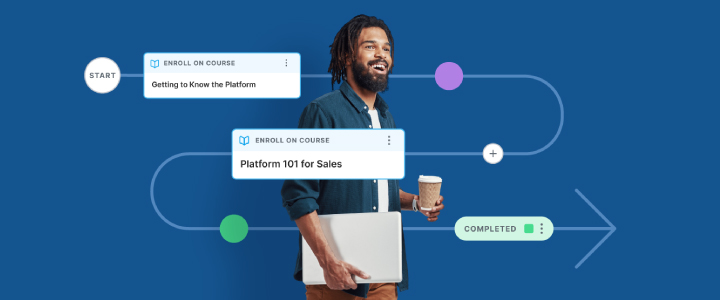
6 min reading time
Kirkpatrick’s Model: How to Calculate eLearning ROI
For most organizations, the value of training is clear-cut. New staff need to be onboarded and educated on tasks that are essential to their role, while current employees utilize training to keep their skills up to scratch. Beyond this, customer training helps to ensure your customers understand your product or service increasing retention, while partner training scales your growth and protects your brand. Basically, training is a no-brainer! At LearnUpon, our customers recognize the value of using a learning management system (LMS) to deliver training, but often ask how they might calculate their eLearning ROI, or return on investment. In this post, we’ll explain what eLearning ROI is, how to calculate it, and the distinct ROI advantages eLearning provides when compared to traditional training delivery.
What is eLearning ROI?
eLearning ROI, is a financial calculation used to assess the monetary benefits of delivering online training programs. With this ROI calculation, the cost of developing and rolling out training is measured against the value or benefits accrued, providing a financial justification for the investment. To consider an eLearning project successful, you should be able to demonstrate that the benefits outweigh the investment. eLearning ROI is essentially a performance measure used by organizations to determine the efficiency of the investment they’ve made in their training initiatives.
Calculating eLearning ROI using Kirkpatrick’s Evaluation Model
Now that we’ve laid out what eLearning ROI is, let’s look at a method that helps you determine if your eLearning programs are achieving a positive ROI. To do this, you’ll need to use Kirkpatrick’s Model of Training Evaluation for the ROI calculation.
What is Kirkpatrick’s Model of Training Evaluation?
The Kirkpatrick Model was developed in the 1950s by Donald Kirkpatrick, a professor, and training specialist. And it’s used by learning and development professionals worldwide to accurately measure training effectiveness. Featuring 4 levels, the Kirkpatrick evaluation model covers everything from the initial reaction of the learner right through to the impact on the organization. Let’s take a closer look at the 4 levels of the Kirkpatrick Model of Training Evaluation, and how you can use it to determine ROI:
Level 1 – Reaction
The reaction level is measured by gathering feedback to understand how learners felt about the training. You can capture your learners’ comments and recommendations by using your LMS to create a post-training survey. This level is important because it lets you know if your learners found the course relevant and alert you to any improvements needed.
Level 2 – Learning
This level determines what was learned by course participants. It evaluates the increase in knowledge and skills, plus changes in behavior. This can be evaluated through the form of assignments, tests, or knowledge demonstrations. This level is important because learning and development specialists can determine if their training objectives are being met, and is another way of identifying knowledge gaps so you can improve your course content.
Level 3 – Behavior
This level is used post course completion and measures how learner behavior has changed as a result of completing training. What skills or knowledge learned during the training are now being applied by your learners? The behavior level is important because it validates the investment made in your organization’s training, but may be more difficult to assess than other levels. An example of such validation would be an improvement in efficiency.
Level 4 – Impact
The impact level measures the final results that occurred because of learners’ participation in the training. Generally, this is measured through a gain in productivity. However, more recently, it’s measured using the Net Promoter Score (NPS). This level should enable you to clearly lay out that you have achieved the desired results, or learning objectives, from the implemented training.
eLearning ROI
Following the 4 levels of Kirkpatrick’s evaluation model, you’ll be able to measure your eLearning ROI. This step is sometimes referred to as Level 5. By monetizing the gains or value added from training and determining if it is more than the investment made, you’ll get your eLearning ROI. This is done by comparing the 4th level to the overall costs of creating, delivering and managing training.
A practical way to apply ROI to your eLearning
Whether you want to train employees, partners, or customers, calculating your eLearning ROI is always beneficial. Now that we’ve broadly explained how the Kirkpatrick Model works, let’s look at a practical way ROI can be applied specifically to eLearning through an LMS.
Assess previous training
Before you implement your training with an LMS, take into consideration your past and present ROI metrics. This gives you a baseline to measure the impact and success your training will have. Let’s say, for example, you want to calculate how your investment in customer training has impacted your organization’s customer support tickets. This can be measured by assessing how many support questions the average customer without training logged over a specific period of time. This number is then measured against support questions logged by customers who’ve completed training. This is a great way to measure if the customer training your organization provides is reducing queries.
Utilize training reports
Through LMS training reports, you’ll be able to measure eLearning’s impact on your ROI. A good LMS should provide you with robust reporting features, including information on learner progression, exam results, module completion, and more. Staying with the support questions example, you could utilize the module completion reporting feature to determine how far your customers have gotten in your courses, and what they have completed. From there, you can delve into discovering the impact training has had on support queries.
Compare your data
With the above steps completed, you’ll be able to compare the performance of your customers who have successfully completed training, versus those who took no training. Compare the number you got from assessing previous training to the number provided through analyzing training reports, and you’ll have your ROI measurement.
A better ROI calculation for eLearning
eLearning is often a preferred choice for organizations, because it eliminates many of the costs associated with traditional training, thus giving you a better ROI. Beyond monetary factors, investing in a LMS also offers more flexible training delivery and more productive processes. If you’re considering shelving your traditional training model and utilizing eLearning to improve your training ROI, here are just some of the benefits you’ll enjoy:
eLearning is more cost-effective
Reducing your reliance on real-world locations and assets allows eLearning to save on many traditional costs. When you switch to online training, expenses for things like hiring onsite facilitators and printing training materials are reduced. Course content is hosted in your cloud-based LMS and accessed by learners when and where it’s required. Keep in mind that it can take time for eLearning to deliver ROI. First, an investment in the subscription cost of an LMS is required. As soon as you start using your LMS to displace traditional training, eLearning will start to generate ROI.
Faster training delivery
eLearning allows you to create more agile processes that benefit both course admins and learners. Online training can be delivered more quickly than traditional methods. When you invest in a cloud LMS, learners can begin to absorb information and develop skills as soon as you launch a course. Hosting content online also allows updates to be made quickly in response to changing business needs. Let’s say feedback indicates that additional customer service training is required for your support team. When training is delivered offline, you must create, print and distribute training materials, book a meeting room, arrange an instructor and confirm learner availability. That’s all just to deliver one customer service training session. If you’ve invested in an LMS, you can simply update the course in your LMS, notify your learners they’ve new training to complete or schedule a webinar session instead. What makes it even more ROI friendly is that you can record the session and make it available to your learners so they can access it at anytime, from anywhere.
Improved training results
The efficiency of eLearning creates better trained learners with improved knowledge retention. When training is conducted online, monitoring and reporting on learner progress is much easier. The impact improved training results have on your eLearning ROI will vary depending on the type of training you’re delivering. If you’re training your customers, you can expect increased retention and opportunities for upselling. Training your partners will ensure they know the ins and outs of your product or service, enabling them to generate more revenue for themselves and your business. A good LMS makes it simple for course admins to run reports that quickly identify knowledge gaps. You can use your LMS’s reporting features to address weaknesses by enrolling impacted learners in training modules that target these gaps. eLearning also allows your learners to become more proactive about training. Uploading resources to a central location allows your learners to access helpful material when and where it’s needed. So in conclusion, because eLearning can be delivered more cost effectively and efficiently, you’re likely to see a better ROI when compared to traditional training methods. But first, you need a great LMS. Book your demo today!



